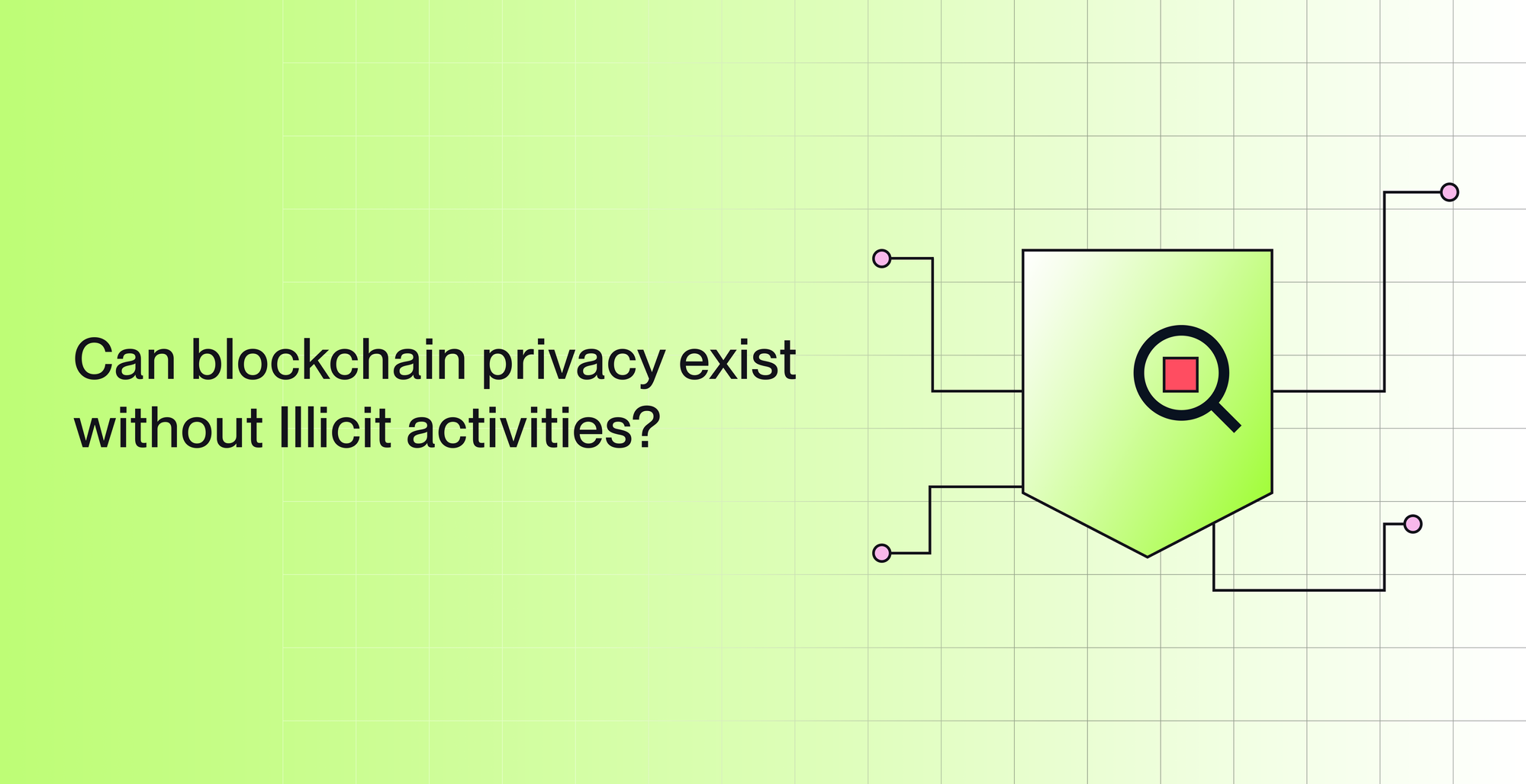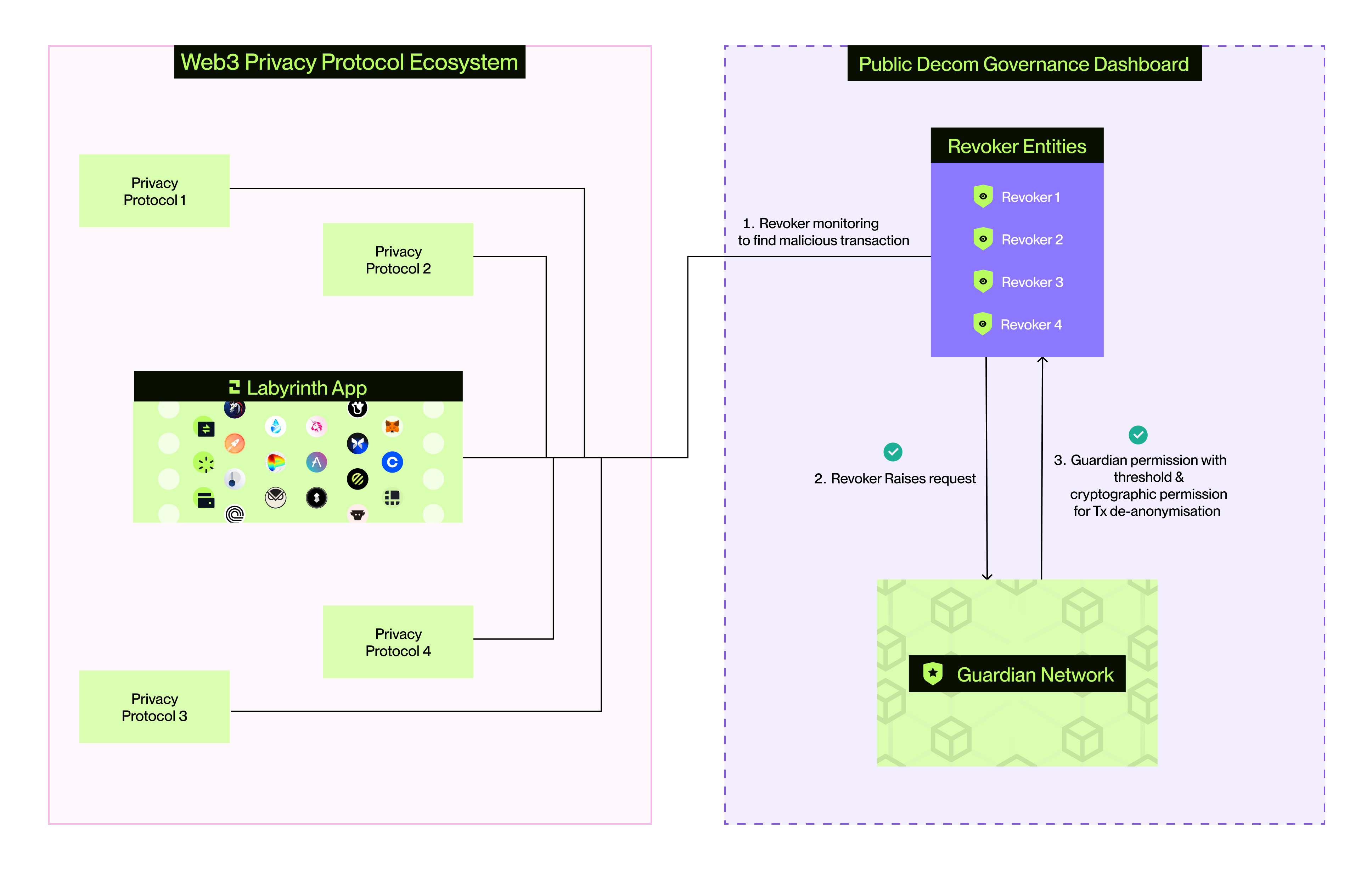Can blockchain privacy exist without Illicit activities?
If you think there’s no way that privacy in DeFi transactions is possible without hurdles, you're in for a treat! In this blog, we’ll delve into how decentralized systems can uphold privacy while ensuring decentralized accountable compliance.

As a protocol striving to balance privacy and regulation, there’s a lingering question that haunts them everytime: How can decentralized compliance function without sacrificing blockchain privacy?
For many, it seems like an impossible balancing act—either you open up the books to regulators or stay fully private, risking a lack of compliance.
But what if there’s a middle path?
A way to keep sensitive data private while still ensuring regulatory compliance?
Enter Decom, a decentralized compliance framework that bridges the gap between privacy and legal obligations in a way that keeps control where it belongs— with the user.
Whether you’re a developer, an institutional investor, or a privacy advocate, Decom is here to ensure compliance without central gatekeeping.
It’s not just a solution for Labyrinth, but a framework for any protocol needing to marry privacy with compliance. Even existing privacy protocols can use Decom to selectively de-anonymize data for regulatory purposes while still ensuring that user control and data privacy remain intact.
But how exactly does it work?
Before we get into the nitty-gritty, let’s break down the key question: How do the actors in Decom—Users, Revokers, and Guardians—work together to balance privacy with regulation? By the end of this blog, you’ll understand:
- The roles of Revokers, Guardians, and YOU (the user).
- Common misconceptions about privacy protocols.
- How other privacy protocols can use Decom to enhance both their privacy and compliance.
Before this, read these to get the full context [if you haven’t already]
- If you want to take the deep road to Decom, read our paper
- How KYC is NOT the solution to Web3 privacy problem— here
- WTH happened to decentralized privacy?--- Read here
Let’s start by diving into who’s involved and how they interact to create a seamless compliance mechanism.
The Players: Users, Revokers, and Guardians
To ensure that Decom can function effectively, each actor plays a unique and crucial role. The interaction between Users, Revokers, and Guardians ensures that privacy remains intact—until the system needs to reveal information for legitimate legal purposes.

1. User: The Privacy Seeker
- Who They Are: The User is any individual, group, or business transacting on the network, expecting that their privacy will be preserved unless they engage in illegal activities. You could be a DeFi enthusiast, a company, or even an institutional investor who values privacy but still wants to stay on the right side of the law.
- How They Operate: Users interact with Labyrinth (or any protocol using Decom) just as they would with any other DeFi platform. But here’s the catch: their transactions are shielded by default. This means that their transaction details stay private unless flagged as suspicious. If a user acts in good faith, their privacy remains untouched. If they engage in illicit activities, a Revoker can flag their transaction for review, and if deemed necessary, it can be selectively de-anonymized by the approval of the Guardians.
2. Revoker: The Compliance Enforcer
- Who They Are: Revokers are neutral entities like DAOs, trusted authorities, or independent gatekeepers responsible for identifying suspicious behavior. They have the task of spotting unusual patterns that could indicate illegal activity, such as money laundering or fraud.
- How They Operate: Revokers monitor blockchain activity using advanced detection systems that identify abnormal patterns. When they spot something suspicious, they trigger a de-anonymization request, but here’s the twist—Revokers can’t unilaterally expose user data. They must submit an encrypted request to the Guardians for approval. Even after approval, Revokers gain only limited, view-only access to the specific flagged transaction, and nothing more.
To ensure that Revokers don’t misuse their power, they face financial penalties (such as the slashing of their staked assets) if they abuse the system. This keeps them in check and ensures the protocol balances privacy with compliance.
3. Guardian: The Decentralized Validator
- Who They Are: Guardians are decentralized entities chosen through governance, and their role is to approve or deny de-anonymization requests from Revokers. They act as the gatekeepers, ensuring transactions are de-anonymised only when absolutely necessary for regulatory compliance.
- How They Operate: When a Revoker submits a de-anonymization request, it’s up to the Guardians to deliberate and decide whether or not to approve it. They do this off-chain to maintain privacy in their decision-making process, but their approvals are publicly verifiable on-chain. Guardians must reach a threshold (e.g., 160 out of 200 approvals) before any data can be decrypted by the Revoker.
If Guardians approve the request, they issue cryptographic permission, allowing the Revoker to view only the flagged transaction. To ensure fairness and accountability, Guardians, like Revokers, face slashing penalties if they abuse their power.
How the System Works Together: A Flow of Trust
Now that we know the roles, let’s look at how these parties work together to maintain privacy while ensuring compliance.

- User Transaction (On-chain): Users submit a private transaction on the protocol, encrypting all the details (e.g., asset ID, value) with a specific encryption key and providing a Zero-Knowledge Proof (ZKP) to prove validity. These transactions stay private unless flagged for suspicious activity.
- Suspicious Activity Detection (Off-chain): Revokers monitor transactions for illegal behavior. If they detect something fishy, they submit a de-anonymization request to the Guardians.
- Guardian Review and Voting (Off-chain): Guardians review the flagged transaction, deliberating whether de-anonymization is necessary. A threshold of approvals is needed to move forward.
- De-Anonymization Execution (Off-chain): Once approved, the Revoker decrypts the specific flagged transaction, gaining view-only access to the necessary information. The rest of the user’s data remains private.
- Post-De-Anonymization (On-chain): If further suspicious activity is discovered, the Revoker submits new de-anonymization requests, ensuring that only targeted transactions are decrypted, keeping privacy intact for all legitimate activities.
Addressing Misconceptions About Privacy and Compliance
Let’s address some of the common misconceptions around privacy protocols and how Decom addresses them.
Misconception 1: You Need KYC for Compliance
Nope. Labyrinth's Decom framework ensures that suspicious activities, like fund cycling or money laundering, are flagged without using privacy-invasive KYC. Revokers monitor transactions for unusual patterns, such as funds being moved between multiple accounts. If suspicious behavior is detected, the transaction is flagged for review by Guardians, initiating the de-anonymization process.
Misconception 2: De-Anonymization Equals Full Exposure
Many fear that triggering de-anonymization reveals all user data or freezes assets, but with Decom, this isn’t the case. De-anonymization is tied to selective disclosure, meaning only the flagged transaction is decrypted, protecting broader privacy. If other linked transactions appear suspicious, each requires a separate request. When approved, only the Revoker has view-only access to the specific transaction, ensuring privacy is preserved while complying with regulations.
Building Trust with Transparency & Network Effect: Decom for All Protocols
Decom isn’t just a solution for Labyrinth—it’s a framework that any privacy protocol can adopt. Whether you’re a protocol like Aztec, Railgun, Renegade, or Hinkal, Decom can strengthen your privacy model while ensuring compliance. This scalability ensures that the more protocols that adopt Decom, the stronger the network becomes, attracting more users and increasing trust across the DeFi ecosystem.
Decom’s public audibility and decentralized governance ensure accountability, while still keeping privacy at the forefront. As regulations evolve, Decom will adapt, working with different jurisdictions to keep blockchain privacy and compliance aligned globally.
Conclusion: Privacy and Compliance Can Coexist
Decom represents a new paradigm in decentralized compliance—a world where privacy and regulation can coexist without central gatekeepers. By balancing selective de-anonymization with decentralized governance, Decom ensures that compliance doesn’t mean compromising your privacy.
As the backbone of Labyrinth’s compliance engine, Decom is already live on testnet, and the real question is: How long before it becomes the standard for privacy protocols across the DeFi ecosystem?
Ready to Experience Decom? Test It Now!
Decom Network is already live! Head over to our testnet and try it out now! You can check the working demo on the release update. We’re gathering feedback and would love your thoughts as we gear up for mainnet!
For more information, check out these important resources:
If you have any questions or want to dive deeper into how Decom works, don’t hesitate to reach out. Join the conversation on Discord or Twitter for the latest updates.

